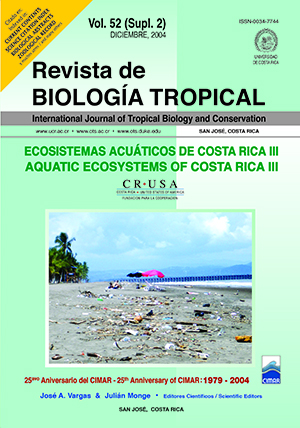Abstract
Thirty-one sediment samples collected from 1996-2003 from the Gulf of Nicoya estuary on the northwestern coast of Costa Rica, have been obtained for PCB analyses. This is part of the first study to evaluate the PCB contamination in coastal Costa Rica.Overall, the concentrations are low, especially when compared to sediments from more temperate climates and/or sediments from more heavily industrialized areas. Values average less than 3 ng/g dw sediment, however, a few samples contained up to 7 ng/g dw sediment. Sediments with the highest concentrations were located in the Punta Morales area, where muds were sampled from among mangrove roots. The Puntarenas samples had surprisingly low PCB concentrations, likely due to their sandy lithology. The congener distribution within the majority of the samples showed signs of either recent sources or lack of degradation. However, a few sites, specifically some of the inter-gulf islands and more remote samples had congener distributions indicative of airborne contaminants and/or degradation. Considering the presence of airborne PCBs in the Gulf of Papagayo to the north, the lack of airborne PCBs and more varied congener distribution in the Gulf of Nicoya estuary was surprising.References
Broman, D., C. Naf, & Y. Zebühr. 1992: Occurrence and dynamics of polychlorinated dibenzo-p-dioxins and dibenzofurans and other combustion related organic pollutants in the aquatic environment of the Baltic. Chemosphere 25:125-128. Epifanio, C.D., D. Maurer & A.I. Dittel. 1983: Seasonal changes in nutrients and dissolved oxygen in the Gulf of Nicoya, a tropical estuary on the Pacific coast of Central America. Hydrobiologia 101: 231-238. Gocke, K., J. Cortés & C. Villalobos. 1990: Effects of red tides on oxygen concentration and distribution in the Golfo de Nicoya, Costa Rica. Rev. Biol. Trop. 38: 401-407.
Rappe, C. 1993: Environmental concentrations and ecotoxicological effects of PCDDs, PCDFs, and related compounds. DIOXIN 93, Organohalogen Compounds 12: 163-170.
Spongberg, A.L. 2004: PCB Contamination in Surface Sediments in the Coastal Waters of Costa Rica. Rev. Biol. Trop. 52 (Supl. 3A): 1-10.
Spongberg, A.L. & P. Davis. 1999: Preliminary investigation of pesticide contamination in Golfo Dulce, Costa Rica. Rev. Biol. Trop. 46 (Suppl. 5): 111-124.
Vanier, C., M. Sylvestre & D. Planas. 1996: Persistence and fate of PCBs in sediments of the Saint Lawrence River. The Science of the Total Environment 192: 229-244.
Vargas, J.A. 1995: The Gulf of Nicoya estuary, Costa Rica: past, present, and future cooperative research. Helgoländer Meeresunters 49: 821-828.
Voorhis, A., C.E. Epifanio, D. Maurer, A.I. Dittel & J.A. Vargas. 1983: The estuarine character of the Gulf of Nicoya, and embayment on the Pacific coast of Cental America. Hydrobiologia 99: 225-237.
##plugins.facebook.comentarios##

This work is licensed under a Creative Commons Attribution 4.0 International License.
Copyright (c) 2004 Revista de Biología Tropical


